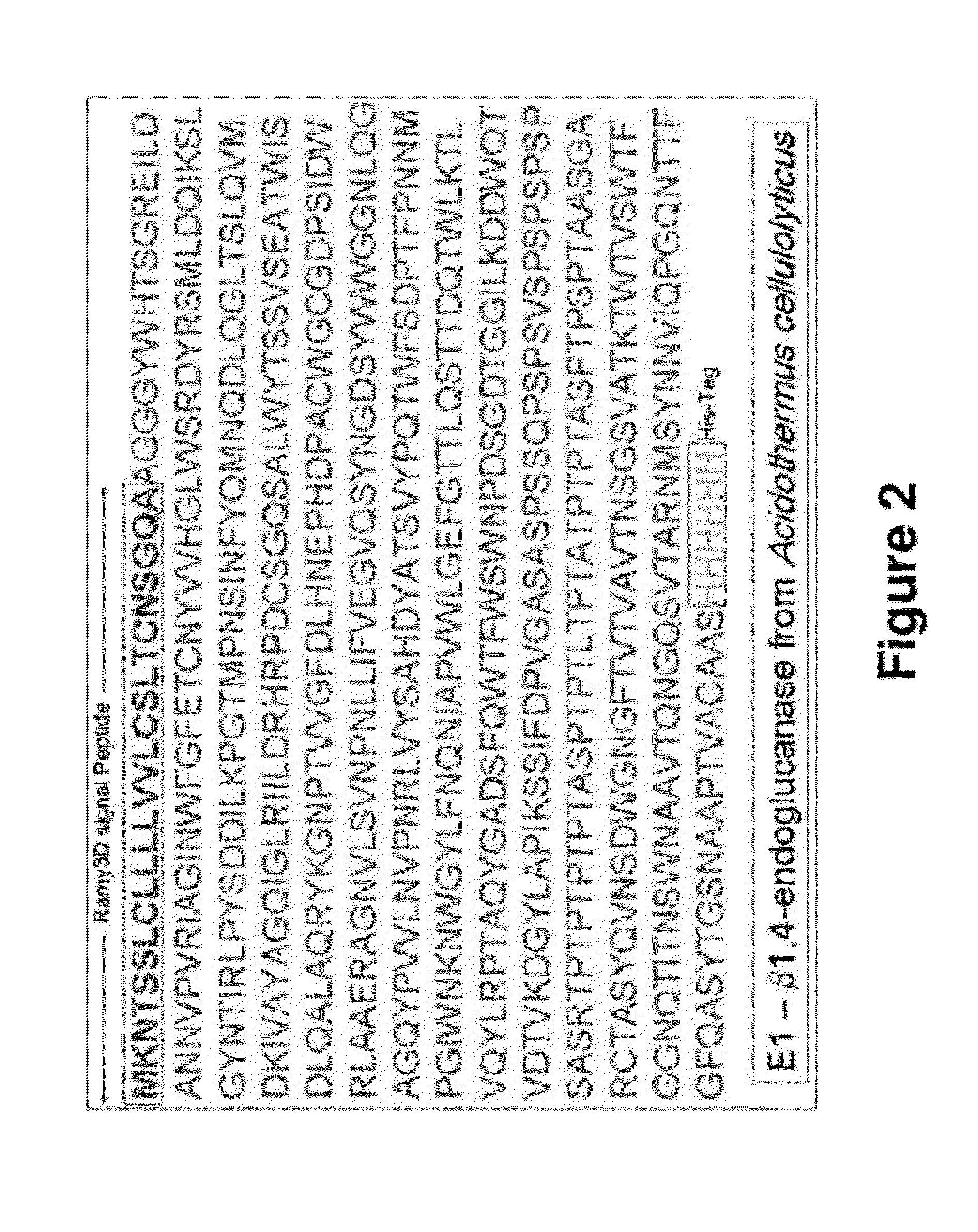Plant-Based Production of Heterologous Proteins
a plant-based and protein technology, applied in hydrolases, biochemistry apparatus and processes, enzymes, etc., can solve the problems of high capital cost, large number of bioreactors, and need for a synergistic set of enzymes to degrade cellulose, so as to facilitate high-yield planta production, reduce production costs, and reduce the need for costly and energy-intensive production
- Summary
- Abstract
- Description
- Claims
- Application Information
AI Technical Summary
Benefits of technology
Problems solved by technology
Method used
Image
Examples
example 1
[0100]Bipartite and Tripartite Cucumber Mosaic Virus (CMV)-Based Expression Vectors for in Planta Protein Expression
[0101]This example describes agroinfiltration-based methods for transient, high-yield production of heterologous proteins in plants. Heterologous protein expression is achieved through the use of a CMV amplicon-based expression system. The CMV amplicon is either encoded by two or three plasmids and contains amplicon segments from one or two viral subgroups.
Bipartite and Tripartite Systems Efficiently Express GFP, RFP and Coat Protein
[0102]First of all, bipartite and tripartite constructs were prepared to make a CMV-based heterologous protein expression system in plant. RFP and GFP expression was tested in bipartite and tripartite systems to confirm that the tripartite system can be used to produce a variety of heterologous proteins in plant. All three genome segments including 35S promoter and terminator sequences were amplified and ligated to pCB301 using blunt-end li...
example 2
Production and Characterization of Endoglucanase (E1) Protein in Pichia pastoris for Use as a Standard
[0115]This example demonstrates that P. pastoris-produced E1 can be used as a standard for the assessment of specific activities and yields of plant-produced E1.
[0116]The Michaelis-Menten kinetic parameters of purified endoglucanase were determined. The E1 was produced in P. pastoris and purified by IMAC (immobilized metal affinity chromatography). The parameters were determined for the specific reaction shown in FIG. 26. E1 cleaves the substrate (MUC) into cellobiose and a fluorophore (MU), the concentration of which can be monitored over time. When run at 65° C. and 135 μM substrate, this is the reaction used for the activity assay for E1 in plant extracts and yeast cultures. In this set of experiments, the substrate concentration was varied to determine the kinetic parameters at different temperatures.
[0117]The rate for a reaction displaying Michaelis-Menten kinetics is shown in ...
example 3
Expression of Endonuclease (E1) in Harvested Sunflower Leaves
[0122]This example explores strategies for the improvement of protein expression methods using Agrobacterium mediated transient expression systems.
[0123]Coinfiltration of with plant hormones. Plant hormones are small molecules that are essential for plant development, differentiation, immune response, or stress response. One interesting fact is that Agrobacteria is known to have genes for the synthesis of plant hormones and alters the hormone balance in plant cells. For this example, a plant hormone was added directly to the Agrobacterium suspension medium and then vacuum infiltrated into plant leaves. FIG. 29 shows the effect of JA (jasmonic acid). As shown in the figure, the addition of 250 μM of JA in the agroinfiltration solution increased expression level of E1 by 3.5 fold at Day 6 compared with the control leaves without JA. Next, the effect of combinations of multiple plant hormones was tested, including jasmonic ac...
PUM
| Property | Measurement | Unit |
|---|---|---|
| temperatures | aaaaa | aaaaa |
| weight | aaaaa | aaaaa |
| temperature | aaaaa | aaaaa |
Abstract
Description
Claims
Application Information
 Login to View More
Login to View More - R&D
- Intellectual Property
- Life Sciences
- Materials
- Tech Scout
- Unparalleled Data Quality
- Higher Quality Content
- 60% Fewer Hallucinations
Browse by: Latest US Patents, China's latest patents, Technical Efficacy Thesaurus, Application Domain, Technology Topic, Popular Technical Reports.
© 2025 PatSnap. All rights reserved.Legal|Privacy policy|Modern Slavery Act Transparency Statement|Sitemap|About US| Contact US: help@patsnap.com



